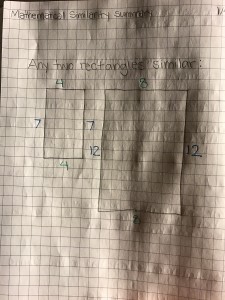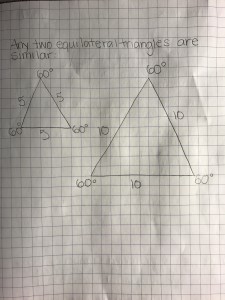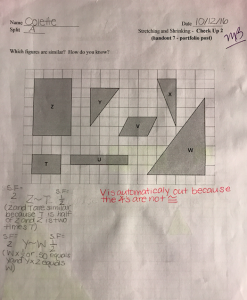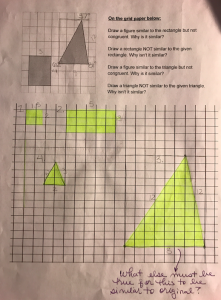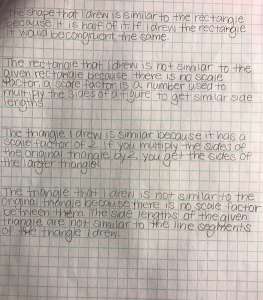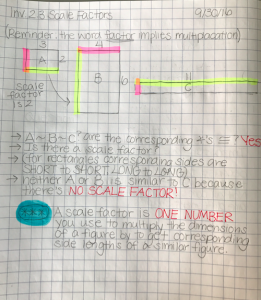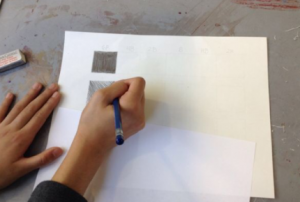Posted on January 4, 2017
Mathematical Similarity Summary
Finish the Statement:
“Figures are mathematically similar when…”
Figures are mathematically similar when they are in proportion to each other.
True or False questions
Any two rectangles are similar:
False, because rectangles don’t always look the same. Although, all rectangles have to have the same lengths on the corresponding sides. As the picture shows, both rectangles have the same lengths on all the corresponding sides. The rectangles do not necessarily have the same size or shape.
Any two equilateral triangles are similar:
True, because all equilateral triangles have the same shape. All sides of an equilateral triangle needs to be equal to each side and all angles must be 60 degrees. No matter what size an equilateral triangle is, it will always stay the same.
Posted on November 8, 2016
Making Thirteen Colonies Chapter 4
Name: Colette September 2016
Seventh Grade Humanities M13C Ch. 4
Homework
Read chapter 4 in Making Thirteen Colonies and answer the following questions using complete sentences. Be sure to use textual evidence and analysis for each question. Each answer should be a full TEEAC paragraph.
- Describe the significance of the year 1607, using the following terms: The London Company, King James, and the name of the 3 boats. Be sure to clearly explain each of these terms within your paragraph.
The London Company, who sponsored the voyagers on their trip to the new world, sent three ships called the Susan Constant, the Discovery and the Godspeed. The London Company is a company in England that has a lot of power and money. The voyagers were looking for gold and resources in the New World. “But it was gold that was on their mind when they reached Jamestown, and they soon began searching for it.” pg 27. However the men wouldn’t find gold, but the London Company needed them to find the gold. “To make things worse, the London Company, which had paid for the voyage, showed poor sense. It gave all the colonists salaries and did not allow them to own property. No one had a reason to work hard, because the hard workers got the same pay as those who did nothing.” pg 28. This shows that the London Company was not thinking, they were not smart to pay the voyagers before they left for the journey to the New World. King James gained the settlers more safety by making a promise with the Spaniards that they would not attack the settlers. Jamestown was named after King James to honor Queen Elizabeth’s cousin. Queen Elizabeth was very liked and praised. In the year 1607, the English started a new colony in the New World.
- Describe the the terrain and the geography of the English fort.
The English settled in the New World, they lived in a small fort called Jamestown, along the James River. Jamestown was an English colony named after the newly crowned king, King James, the James River was also named after King James. “The settlement is protected by a ditch and palisade (a high fence made of stakes).” pg 26. This shows that the settlers cared a lot about protection and defense. “Most of the houses have thatched roofs made from river grass or reeds, but some are covered with tree bark (an idea borrowed from the Indians). This is important to note because it seems like it could increase the change of have fire. Fire could burn down the settlement easily.
- Was the initial settlement successful? Why or why not?
The initial settlement was not successful. The land was very murky and the water was brackish. The English chose a terrible spot to colonize in, the land around Jamestown was muddy so they could not plant crops or start farms. “As it turned out, they couldn’t have picked a worse spot. The land was swampy, the drinking water was bad; it was hot in summer and bone-chilling in the winter. The mosquitoes drove the settlers crazy and carried malaria germs.” pg 28. The spot in which the settlers lived was not ideal. There was a lot of germs and sickness from the brackish water that the settlers drank. This is why the initial settlement and the choice to move to the New World was not successful.
Posted on November 8, 2016
Apprenticeship Notecard
Quote: “In most of the colonies, apprenticeship training was a common way for children to acquire a basic education in literacy. A second, equally important benefit was learning a trade or craft that would enable a young man to start a business. As a skilled worker, he had a better chance of earning enough to start a business. As a skilled worker, he had a better chance of earning enough to support a family and remain financially independent. As a population of the colonies grew, so too did the need for skilled workers. After a child had completed an elementary education at a dame school, his family might enroll him in a grammar school or arrange for him to become an apprentice. Since most boys weren’t going to college, there was no reason for them to attend grammar school. An apprenticeship was practical alternative. The apprenticeship system in New England had the backing of the law. Apprenticeship laws required the master tradesman or craftsman to continue the literacy training of his young apprentice while teaching him the skills he would need in his particular field. The laws also required the master to support his apprentice food and shelter and other necessities. There was nothing in the laws about compulsory. However, the master was legally obliged to make sure his apprentice learned to read. Contracts between the child’s family and the master were signed. The courts had the power to enforce the terms if either party failed to meet them. Apprenticeships usually began when the child was around eight or nine and lasted until the age of twenty-one for boys and eighteen for girls. Massachusetts in 1710 amended its apprenticeship laws to require boys to learn both reading and writing and girls to learn only reading. Male apprentices learned a range of skills, from blacksmithing to tailoring. But female apprentices were only expected to learn ‘women’s work’ or ‘house-wifery.’ According to the Puritan view, writing (actually, penmanship) was not something women needed to know in order to be competent homemakers. Men, on the other hand, were preparing for employment as skilled workers. For them, writing was an essential skill.”
Paraphrase:
- Training for apprenticeship is common for people to get a education.
- Apprenticeship also taught young men how to start their own business. Although, they could also work for their master or anyone of their choosing.
- If you were a skilled worker, you could have a higher chance to start your own business, if you weren’t such a skilled worker, you had a lower chance of starting a business, so you would probably end up working for your master.
- Being a skilled worker, gains you more pay, resources and power. This is the same as today, if you are good at your job, you will be more financial.
- Once a boy had finished elementary school (dame school) he would go to grammar school or become an apprentice.
- Most boys did not go to college, only the gentry class did, their parents would not pay or enroll their children in grammar school. Instead, most people would go to train for apprenticeship.
- Most boys would try our for apprenticeship after dame school, elementary school.
- The laws for apprenticeship masters were for them to include food and shelter for their apprentices.
- The apprenticeship master had to teach his or her apprentice how to read.
- Most apprenticeships started at the age eight or nine and ended until twenty one for boys and eighteen for girls.
- In 1710, Massachusetts the laws for apprenticeship needed boys to learn how read and write but, girls on the other hand, only had to learn how to read.
- Boys got to choose from a big amount of choices such as blacksmithing or tailoring. Although girls only got to be educated in “women’s work” this was cooking, learning to read, clean and so much more.
- Penmanship was not that important to women because it does not show up that much in housework. For men, penmanship was important because this was how they prepared for work when they got older.
My Ideas: I think apprenticeship was really unfair in the Colonial times because women were not expected to learn as much as men did. Also, from a mans point of view, they had to be in apprenticeship longer than women and also had to take the responsibilities of the financial part of the family. They were the only ones who had to make a living for the family. Men were educated in all different kinds of things and went to all different kinds of schools but, girls only had to go to Petty School or Dame School. From a girls point of view, having the right of not going to school for longer, or having a better educational experience in being an apprentice was unfair. Girls also only got to have a small matter of choices and boys had a huge spectrum of choices, they could choose practically whatever job they wanted to apprentice in. Girls only got to do housework during apprenticeship and did not learn any other type of schooling education other than reading. It is interesting how important reading was for the colonists. Was reading a big part of their daily life? It is still really important to learn how to read now but it is as important as writing. I feel like women would really need to know how to write too so they could teach their children how to read and write. It also takes writing skills to do math, wouldn’t the mothers need to teach their children mathematics? I also find it confusing that penmanship is important for men and is not important for women. I feel like women would need to have good penmanship so they could teach their children how to read, write and do mathematics. Although, they also have to do a lot of labor and housework too. I feel like men would need to do a lot of labor too when they are working. It is unfair how women don’t get to have the right to go to work and make money. On the other hand, men don’t have too much time to relax, they have to do work all day. In the Native American cultures it is not like this and the Enslaved Africans lives are even more hard work. In Virginia, the Native Americans share all the work and the women do a lot of the hard work. The women farm, cook and more, all these things women do are very important. Men also do the same tasks as women, this makes Virginia equal. When the Europeans came to the New World, they messed up the Native American’s ways. They created un-fairness in the Native American culture by only letting some be educated. I am sure the Enslaved Africans did not have the same rank of un-equal-ness as the Europeans did before they were captured. I feel like the Europeans created all the chaos in the world now because of their un-fairness. For example, the Europeans only let the top few have good education and did not let the lowest of the low get education at all. It is against the rules for them to even have education! I believe this is racist because the Europeans are only allowing the white people be educated. Even the white slaves can be educated and the colored slaves cannot. The Native Americans did not have apprenticeship, the whole community did everything and everybody did everything. Unlike the Europeans, the men had some choices to chose from and women had some choices to chose from. Men and women could never do the same job.
Posted on November 8, 2016
The Giver Essay
No Emotions
Name: Colette Humanities
7th Grade The Giver
What if there was a society in which no one could feel emotions? What if people never felt pain, loneliness, sadness or happiness? This is true for the community in the book, The Giver by Lois Lowry. Jonas, a twelve year old boy, was selected to be the Receiver of Memory. It is the most important and respected job in his community. Jonas takes on the task of seeing memories and feeling new things, like emotions. This makes him different. Jonas’s society is a dystopia because the community doesn’t allow anyone to have emotions. The society seems like a utopia in some ways because the elders hold back the feeling of pain and loneliness from the community, but in reality, pain is something we can all learn from and is an important emotion for everyone to experience.
One way that Jonas’s community tries to be a perfect society is by not allowing anyone to feel pain. This insures that there are no differences between the people in the society. For example, when Jonas was selected as the next Receiver, the elders know that Jonas will feel terrible pain that he has never experienced before and that he will struggle through it. Only Jonas and the Giver are allowed to experience this sensation. On page 95 it says, “‘Why do you and I have to hold these memories?’ ‘It gives us wisdom,’ the Giver replied.” Jonas and the Giver obtain knowledge and memory, and as a result, experience pain. The elders need to keep the community in order and to have everyone be the same.They are preventing the community from having the whole human experience. Jonas can now feel both physical pain and mental pain too. He is starting to feel emotions such as sadness, love and fear. Emotions like pain makes Jonas feel alone. Although Jonas experiences terrible emotions like pain and loneliness, these emotions can later help us and gain wisdom.
Loneliness is a meaningful and life-changing emotion that Jonas experiences. It changes the way Jonas thinks by a great amount. Loneliness is a feeling of pain and grief. It’s a unique experience and a huge new shock for Jonas. Feeling alone is a hurtful emotion, it makes Jonas feel depressed and scared. Having emotions is a new way of thinking for Jonas, especially feeling pain and loneliness. For example, Jonas’s community doesn’t know anything about pain and feeling alone. On page 133 and 134, Lois Lowry writes, “Jonas stood alone in the center of the field. Several of the children raised their heads and looked at him uneasily… One of the children raised an imaginary rifle and made an attempt to destroy him with a firing noise. ‘Pssheeew!’ Then they were all silent, standing awkwardly, and the only sound was the sound of Jonas’s shuddering breaths. He was struggling not to cry,” (Giver, pg 134) Because Jonas is one of the only people who can feel pain, other people and children in the society don’t understand how and what he is thinking. In Jonas’s community, having emotions is like being in a whole new world, because no one else in the community knows what he and the Giver are feeling.
This community is a dystopia, because the people in the society aren’t able to feel emotions such as pain and happiness. Pain helps us grow stronger and helps deal with hardships later in life. Happiness is a moment of joy, it’s lucky to feel happy, but the society took this away from the people. Difference is fortunate, and Jonas gains this fortune. Jonas imagines creating a better world by letting everyone experience the full range of emotions.
Posted on November 8, 2016
Ecology Action Projects and Muir Web
One of the projects we are working on this year are our ecology action projects. Each group has a different topic to focus on. Our topic is to build a hydroponic plant system indoors. The plants we will be growing are arugula and romaine lettuce.
In my science group, we are making a hydroponic system for hydroponic plants. The picture above is a muir web of arugula. We have been using a program called spider scribe, you can use this program to make maps and muir webs. Our group will build a hydroponic garden for arugula and romanie lettuce. We will be tracking how it is growing and how well it does in a hydroponic system.
Posted on November 8, 2016
Muir Web
This year in the first quarter we made muir webs. Muir webs are maps showing how everything connects. This muir web is about me and what I ate. This muir web shows how all the food I ate and what the food is connected to. For example, one of my foods are yogurt, I put everything that is put into the yogurt, who made the yogurt and what the habitats were for everything that was in the yogurt. One thing that I could’ve fixed is adding who the predators were for the plants. Overall, I am proud of this muir web and I feel like I understand it well.
Posted on November 1, 2016
Stretching and Shrinking Check up 2
So far in the first third, we are learning about stretching and shrinking shapes. This is our stretching and shrinking check up #2.
On the first page, the question was, “Which figures are similar? How do you know?” I thought that Z and T were similar and Y and W were similar.
I thought that Z and T were similar because T is half of Z and Z is two times the amount of T. This makes the scale factor from Z to T 2, and the scale factor from T to Z 1/2.
I thought that Y and W were similar because W times 1/2 or .5 equals Y, and Y times 2 equals W. The scale factor is the same as Z and T. The scale factor from Y to W is 2 and the scale factor from W to Y is 1/2.
The first question on the second page is, “Draw a figure similar to the rectangle but not congruent. Why is it similar?” I drew the rectangle which is labeled 1, on the second picture. The shape I drew is similar to the rectangle in the picture because it is half of the size of the original rectangle. Now the side lengths are 1.5 by 2, instead of 3 by 4.
The second question is, “Draw a rectangle NOT similar to the given rectangle. Why is it similar?” I drew the rectangle which is labeled 2. The rectangle that I drew is not similar to the given rectangle because the side lengths do not match up at all. The side lengths are 5 by 3 and the original side lengths are 3 by 4.
The third question is, “Draw a figure similar to the triangle but not congruent. Why is it similar?” I drew a triangle labeled on the sheet, number 4. This triangle is similar to the original triangle because it has a scale factor of 2. The reasoning behind this is that if you multiply the sides of the original triangle by 2, you get the lengths of the larger triangle. Now the lengths of the larger triangle are 12 by 12 by 8.
The fourth question is, “Draw a triangle NOT similar to the given triangle. Why isn’t it similar?” I drew the triangle that is labeled 4. The triangle that I drew is not similar to the given triangle because the lengths do not match up. It is also a totally different shape than the given triangle and the proportions of the triangle I drew are all different. The lengths are now 3.1 by 3 by 2, this does not match up with the larger triangle. The lengths of the given triangle are 6 by 4 by 6.
Posted on October 30, 2016
Math Notetaking
This is an example of bad note taking because it is too colorful and un-organized. When I look back at this page when I am studying for a test, it will be hard to read and hard to understand. Some of the words are all over the place and I do not know what it matches to.
This is an example of good note taking in my preference because it has a title, date and it is very organized. This page would be a good recourse to look back on when I am studying on a test because it explains what is happening on in this page and including to everything else on this page, it also talks about scale factors.
Posted on October 25, 2016
Giver Essay Template 2016
Outline for GIVER LITERARY ESSAY
Themes: Pain and Loneliness
Paragraph #1: Introductory Paragraph (GIT)
Grabber Statement (G): What if there was a society who didn’t feel emotions? Who never felt pain, loneliness, sadness or happiness? This is true for the community in the book The Giver by Lois Lowry.
Introduce Plot Summary (I): Jonas, a twelve year old boy, was chosen to be the Receiver of Memory. It is the most important and most respected job among the people. Jonas takes on the task of seeing and feeling new ideas, such as emotions. This makes him different.
Thesis Statement (T): This society is a dystopia because the community doesn’t allow anyone to have emotions. The society seems like a utopia in some ways because the elders hold back the feeling of pain and loneliness from the community, but in reality, pain is something we can all learn from and is an important emotion.
_________________________________________________________________________
Paragraph #2: Thematic Analysis
Topic Sentence (T): One way that Jonas’s community tries to be a perfect society and make everyone the same is by not allowing anyone to feel pain.
Explanatory Sentence (E): The elders do not want people in the community to feel pain or emotions. This insures that there are no differences between the people in the society.
Evidence (E): For example, when Jonas is selected as the next Receiver, the elders know that Jonas will feel terrible pain that he has never experienced before and that Jonas will struggle through it. Although it actually makes Jonas a s It gives us wisdom and strength. Jonas will have a special honor to have the impression of pain that only he and past receivers have felt. On page 95 it says, “‘Why do you and I have to hold these memories?’ ‘It gives us wisdom,’ the Giver replied.”
Analysis (A): This shows that Jonas and the Giver are one of the only people who can feel pain. Jonas and the Giver obtain knowledge and memory, and as a result, experience pain. The elders need to keep the community in order and to have everyone be the same.They are preventing the community to have the reaction of the whole human experience. But Jonas and the Giver are different. Jonas can now feel both physical pain and mental pain too. He is starting to feel emotions such as sadness, love and fear.
Concluding/ Transition (C): Emotions like pain makes Jonas feel alone. Feeling pain and loneliness is required for Jonas. He and the Giver are the only ones in the community who take in all the pain and loneliness. Although feeling pain and loneliness is not a bad thing, it does later help us and makes us wiser.
__________________________________________________________________________
Paragraph #3: Thematic Analysis Continued
Topic Sentence (T): Loneliness is a meaningful and life-changing emotion that Jonas experiences. It changes the way Jonas thinks by a great amount.
Explanatory Sentence (E): Loneliness is a feeling of pain and grief. It is a unique experience and a huge new shock for Jonas. Feeling alone is a hurtful emotion, it makes Jonas feel depressed and scared.
Evidence (E): Having emotions is a brand new way of thinking for Jonas, especially feeling pain and loneliness. For example, Jonas’s community doesn’t know anything about pain and being alone. On page 133 and page 134, Lois Lowry writes, “Jonas stood alone in the center of the field. Several of the children raised their heads and looked at him uneasily.” “One of the children raised an imaginary rifle and made an attempt to destroy him with a firing noise. ‘Pssheeew!’ Then they were all silent, standing awkwardly, and the only sound was the sound of Jonas’s shuddering breaths. He was struggling not to cry.”
Analysis (A): Because Jonas is one of the only people who can feel pain, other people and children in the society don’t understand how he is thinking. Having emotions in Jonas’s community is really unimportant because the utopia does not have emotions anymore like they used to. That caused a dystopia.
Concluding/ Transition (C): Having emotions is like being in a whole new world. Jonas is starting to be experiencing happiness, sadness, pain, loneliness and more.
__________________________________________________________________________
Paragraph #4: Concluding Paragraph (ROC)
Reflection on Thesis (R): I have proven that the community is a dystopia, because the people in the society aren’t able to feel emotions such as pain and happiness.
Overview of Main Points (O): Pain helps us grow up stronger and help deal with hardships later in life. Happiness is a moment of joy, it’s lucky to feel happy, but the society took this away from the people.
Concluding Sentence– Comparisons and Connections (C): Difference is fortunate, and Jonas gains this fortune. Jonas imagines to create this a better world by letting everyone have the impression of emotions.
Posted on October 7, 2016
Value Chart Response
https://app.seesaw.me/#/student/feed/class.cb7951d9-b4b3-451e-ad44-a3ffb8f1d6d9/person.e1dada72-08b0-4f7d-a764-7b3dbb5bb812
“Discuss the technique your working on in this photograph.”
I am working on cross hatching. Cross hatching is a different kind of hatching. Cross hatching is when you draw lines from top to bottom, left to right, top left to bottom right and top right to bottom left. This technique is usually used to blend, making your sketching and coloring more even.

